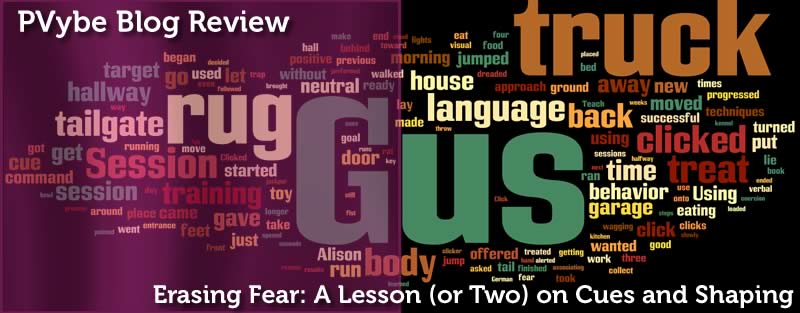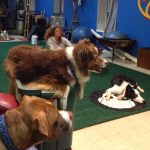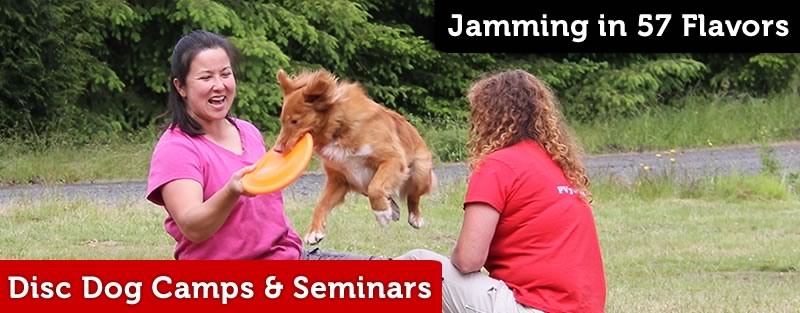
Four Qualities of Good Dog Trainers
I ran across this great article on Clickertraining.com. This is how it’s done. It’s a long article written by Clint Matthews about overcoming an early adolescent fear that was having an impact on their hunting/gun dog performance in 15 short clicker training sessions:
Problem: truck terror
Gus, a three-year-old German shorthaired pointer (GSP), is fearful of our truck. Gus shows undesirable body language (tucked tail, head lowered, and slinking movement) in the general vicinity of the truck and in the garage. He knows when it is time to go to the truck—when I go out into the backyard on Saturday mornings to take him to the truck, he shows the same body language. Gus especially dislikes the long hallway that leads from the kitchen to the garage because he knows the truck is right behind the door!
Until now I have had to use strong and forceful voice commands to get Gus to go to the truck and load. I was getting it done, but he wasn’t happy about it. I tried many things to change his body language, such as not bringing him through the house to the truck. It was all trickery. But, there was no fooling him—as soon as he saw the truck and knew my intentions, Gus began to slink.
Desired outcome: fear-free truck travel
The goal was for Gus to lose his fear of the truck, loading into the truck with good body language (wagging tail, head and ears up) and without any coercion.
You really should read it. It’s a really great summary of some good dog training.
There were a few things that struck me as important to Clint & Gus’ success: flexibility, creativity, patience, and method.
Flexible
As I see it, Clint shifted gears 3 times – walking, targeting, access to his wife (have to read it, lol), and then spot Spot is a “go to a place”, or “go to a mat” behavior. This means that the dog seeks out and performs a duration behavior on a spot of the handler’s choosing. A... More. This was done on the fly-ish, as plan B kind of work. How you handle plan B is really important. “Umm… this doesn’t seem to be working…” or “This doesn’t seem to be getting better…” The altering of criteria for the success of the dog and for the flow of the training session is a huge part of training and Clint seems to have nailed it.
Spot is a “go to a place”, or “go to a mat” behavior. This means that the dog seeks out and performs a duration behavior on a spot of the handler’s choosing. A... More. This was done on the fly-ish, as plan B kind of work. How you handle plan B is really important. “Umm… this doesn’t seem to be working…” or “This doesn’t seem to be getting better…” The altering of criteria for the success of the dog and for the flow of the training session is a huge part of training and Clint seems to have nailed it.
Creative
The application of the Spot (“Rug” from the article) in the hallway, outside, on and in the truck was a great idea, as was the hand targeting for good movment down the hallway. The rewarding with a foodbowl, your dog’s actual dinner bowl is a clever idea. Talk about motivation and reward placement! This kind of creativity allows you to leverage your patience and flexibility while rounding out the dog’s behavior with these skills. Oh, capitalizing on the run with Alison was a real game changer…
Patient
While Clint was flexible, he was also patient. He didn’t try to push the dog. I don’t understand why people (myself included) need to push the dog. Why do we do that? I’m much better now at quitting before the dog struggles, but it still happens. When that happens we undo our hard work, or the dog wind ups doing the skill in weak fashion as was the case with Clint’s dog and the hand targeting through the hallway. Fortunately, Clint recognized that issue and shifted gears.
Methodical
The moving of the spot down the hall in distinct increments, the increased distance on the target, thoughtful usage of higher quality food, and general upping of the criteria in a logical and forward leaning manner helps to pull the dog into performing the behavior. The creativity and flexibility to raise or lower criteria, or to change the criteria entirely and work other aspects can be leveraged to keep the momentum going forward.
The Rub
The hard part is balancing all of this. How you are flexible? When you are creative? “Should I be patient now, or not?” Does the methodology fit your training ideology? “Am I being creative or just impatient?”
All of these questions are hard to answer and the answers can change situationally. How you answer them is important, but what you actually do on the fly, while you are working your dog, that is what counts.








